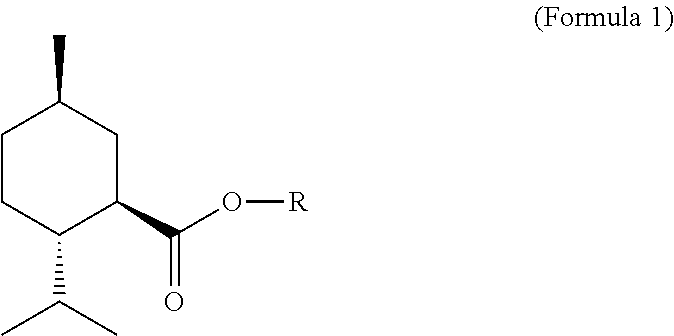Treatment of eye discomfort by topical administration of a cooling agent to the external surface of the eyelid
a cooling agent and eyelid technology, applied in the field of eye discomfort treatment, can solve the problems of eye drops being difficult to administer and eye drops are relatively inefficient methods of delivery
- Summary
- Abstract
- Description
- Claims
- Application Information
AI Technical Summary
Benefits of technology
Problems solved by technology
Method used
Image
Examples
example 1
[0096]The general procedure for testing was to weigh an active ingredient and to disperse it within a saline solution (i.e., Bausch & Lomb, Sensitive Eyes Plus Saline Solution) at stock concentrations of 10 to 20 mg / mL. Test solutions were further diluted with isotonic saline. For single assays, a 1 mL scaled pipette was used to dispense 0.8 to 1 mL of test solution onto a sterile 2″×2″ (5 cm×5 cm) pad, made of rayon-polyester formed fabric (Walgreens Sterile Gauze Pads) weighing on average 285±9 mg.
[0097]For safety precautions, the wet pad was first tested by applying the pad to the philtrum, to determine if there was any irritation or pain. No irritancy was observed with any of the test substances.
[0098]In the next trials, the wet pad was wiped twice over the closed eyelids of each eye from the medial to the lateral canthus. By subtraction, the loss of weight of the pad averaged 32±1 mg. Thus, each eye received ˜16 μL of the test solution per eye. For a 1 mg / mL solution this was e...
example 2
[0102](R)-2-[((1R,2S,5R)-2-isopropyl-5-methyl-cyclohexanecarbonyl)-amino]-propionic acid ethyl ester, referred to as CPS-369 (see, e.g., Wei, 2008) was synthesized and tested. This compound, which is a white solid at room temperature, was dispersed in saline solution by sonication and tested at 1 mg / mL and 2 mg / mL. Robust and refreshing cooling was obtained lasting approximately 1.5 and 2.5 hours, respectively. It was noted, however, that after testing, if the subject was to get their eyelids wet, for example, from perspiration, taking a shower, or washing the face with a towel, the cooling sensations returned, sometimes with an intensity that could cause discomfort. This side-effect, which was attributed to activation of residual solid test substance deposited on the eyelid which then washed onto the corneal surface, indicated that solid cooling agents were not ideal as active ingredients. An active ingredient should be water soluble so that it can be flushed out of the eye after a...
example 3
[0104]2-[((1R,2S,5R)-2-isopropyl-5-methyl-cyclohexanecarbonyl)-amino]-acetic acid 3-hydroxypropyl ester, referred to as CPS-160 (see, e.g., Wei, 2008) was synthesized and tested. CPS-160 was first computationally predicted to be a water soluble liquid at room temperature. This compound, when synthesized, is a colorless liquid and was solubilized in saline solution and tested at 2 mg / mL. Robust and refreshing cooling was obtained in the orbit lasting approximately 0.6 hours. It was noted, however, that solutions were not stable and became inactive after 2 days when stored at room temperature. Thus, CPS-160 was not considered to be an optimal cooling agent for practicing the invention.
PUM
| Property | Measurement | Unit |
|---|---|---|
| Electrical conductance | aaaaa | aaaaa |
| Concentration | aaaaa | aaaaa |
Abstract
Description
Claims
Application Information
 Login to View More
Login to View More - R&D
- Intellectual Property
- Life Sciences
- Materials
- Tech Scout
- Unparalleled Data Quality
- Higher Quality Content
- 60% Fewer Hallucinations
Browse by: Latest US Patents, China's latest patents, Technical Efficacy Thesaurus, Application Domain, Technology Topic, Popular Technical Reports.
© 2025 PatSnap. All rights reserved.Legal|Privacy policy|Modern Slavery Act Transparency Statement|Sitemap|About US| Contact US: help@patsnap.com



